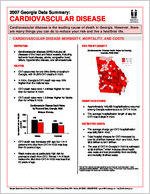2007 Georgia Data Summary:
CARDIOVASCULAR DISEASE
Cardiovascular disease is the leading cause of death in Georgia. However, there are many things you can do to reduce your risk and live a healthier life.
CARDIOVASCULAR DISEASE MORBIDITY, MORTALITY, AND COSTS
DEFINITION
Cardiovascular disease (CVD) includes all diseases of the heart and blood vessels, including ischemic heart disease, stroke, congestive heart failure, hypertensive disease, and atherosclerosis.
DEATHS
CVD accounted for one third (34%) of deaths in Georgia, with 21,873 CVD deaths in 2005.
In 2004, Georgia's CVD death rate was 13% higher than the national rate.
CVD death rates were 1.4 times higher for men than for women in 2005.
CVD death rates were 1.3 times higher for blacks than for whites in 2005.
Cardiovascular Disease Death Rates by Race and Sex, Georgia, 2005
Black White
600
435
400
348
323
251
200
Age-adjusted rate per 100,000 population
0 Males
Females
CVD death rate increases with age but 1 in 4
persons who died from CVD in 2005 was less than 65 years of age.
Black males are at particularly high risk for
premature death from CVD. Almost 1 in 2 black males who died from CVD in 2005 was less than 65 years of age.
DEATHS BY COUNTY
Cardiovascular Disease Death Rates by County, Georgia, 2000-2005
HOSPITALIZATIONS Approximately 142,400 hospitalizations occurred among Georgia residents due to CVD in 2005. The average hospitalization length of stay for CVD was 5 days in 2005.
ESTIMATED COSTS The average charge per CVD hospitalization was $28,700 in 2005.1 Total hospital charges for CVD increased by over $1.6 billion between 2001 and 2005, from $2.5 billion to $4.1 billion. The cost of CVD in Georgia in 2005 is estimated at $9.8 billion,2 which includes direct health care costs and lost productivity from morbidity and mortality (indirect costs).
1Derived from national estimates published by the American Heart Association. Heart Disease and Stroke Statistics - 2005 Update. Dallas, TX: American Heart Association; 2005. 2Hospital charges from acute care non-federal hospitals
Georgia Department of Human Resources, Division of Public Health 2 Peachtree Street, NW Atlanta, GA 30303 (404) 657-3103 ga-cvh@dhr.state.ga.us http://health.state.ga.us
SMOKING
CARDIOVASCULAR DISEASE RISK FACTORS
OBESITY
3,696 deaths due to CVD were attributable to smoking among adults ages 35 or older in 2005.
Quitting smoking greatly reduces the risk for heart disease and stroke.
Obesity, which is present in 27% of adults in Georgia, increases the risk of cardiovascular disease.
HIGH BLOOD PRESSURE
In Georgia, 20% of adults reported smoking cigarettes in 2006.
LACK OF PHYSICAL ACTIVITY
Lack of physical activity increases the risk for heart disease and stroke.
High blood pressure can be controlled through lifestyle changes such as physical activity and healthy diet and, if necessary, medications.
The percentage of adults in Georgia who have been told that they have high blood pressure increased from 20% in 1995 to 27% in 2005.
Regular physical activity helps to maintain proper body weight and improves general health.
In 2005, 58% of adults in Georgia did not meet the Centers for Disease Control's recommendations for physical activity.
POOR EATING HABITS
HIGH CHOLESTEROL
Many people can control high cholesterol by modifying their diet. For those who cannot, medication can lower blood cholesterol levels.
The percentage of adults in Georgia who have been told that they have high cholesterol increased from 22% in 1995 to 32% in 2005.
Poor eating habits such as a high-fat diet can lead to obesity, ischemic heart disease, stroke and other chronic diseases.
Eating five or more servings of fruits and vegetables a day can help prevent heart disease, cancer, and other chronic conditions.
The majority (77%) of adults in Georgia did not consume the recommended five or more servings of fruits and vegetables per day in 2005.
DIABETES
Diabetes can cause atherosclerosis, also known as hardening of the arteries.
Diabetes increases the risk for CVD death.
The percentage of adults who report having diabetes increased from 4% in 1995 to 9% in 2006.
Percent
Prevalence of risk factors for cardiovascular disease among adults, Georgia, 2005 and 2006
100
77 80
58 60
40 20
20
27
27
32
0
Current smoker*
Not meeting
<5 fruits and
recommended physical vegetables per day
activity
Obese*
Ever had high blood pressure (1)
Ever had high cholesterol (2)
9
Diabetes*
(1) The percentage of Georgians who reported having been told they had high blood pressure (2) Of persons who had their blood cholesterol level checked, the percentage told that they have high cholesterol
* Data Source: Georgia Behavioral Risk Factor Surveillance System 2006
Data Source: Georgia Behavioral Risk Factor Surveillance System 2005
Date updated: July 2007 Publication number: DPH07.104HW Visit http://www.health.state.ga.us/epi/cdiee/cardio.asp for more information about cardiovascular disease in Georgia.
Georgia Department of Human Resources, Division of Public Health 2 Peachtree Street, NW Atlanta, GA 30303 (404) 657-3103 ga-cvh@dhr.state.ga.us http://health.state.ga.us
